Complete Solutions to problem for practise of chapter CARBOXYLIC ACIDS AND THEIR DERIVATIVES of Class 12 book with complete answers and questions
| Class 12 | CHEMISTRY |
| Chapter | CARBOXYLIC ACIDS AND THEIR DERIVATIVES |
| OP TANDON | problem for practise |
| Number Of Questions | 31 |
| Academic Year | 2023-24 |
Write the final product in the following reactions:
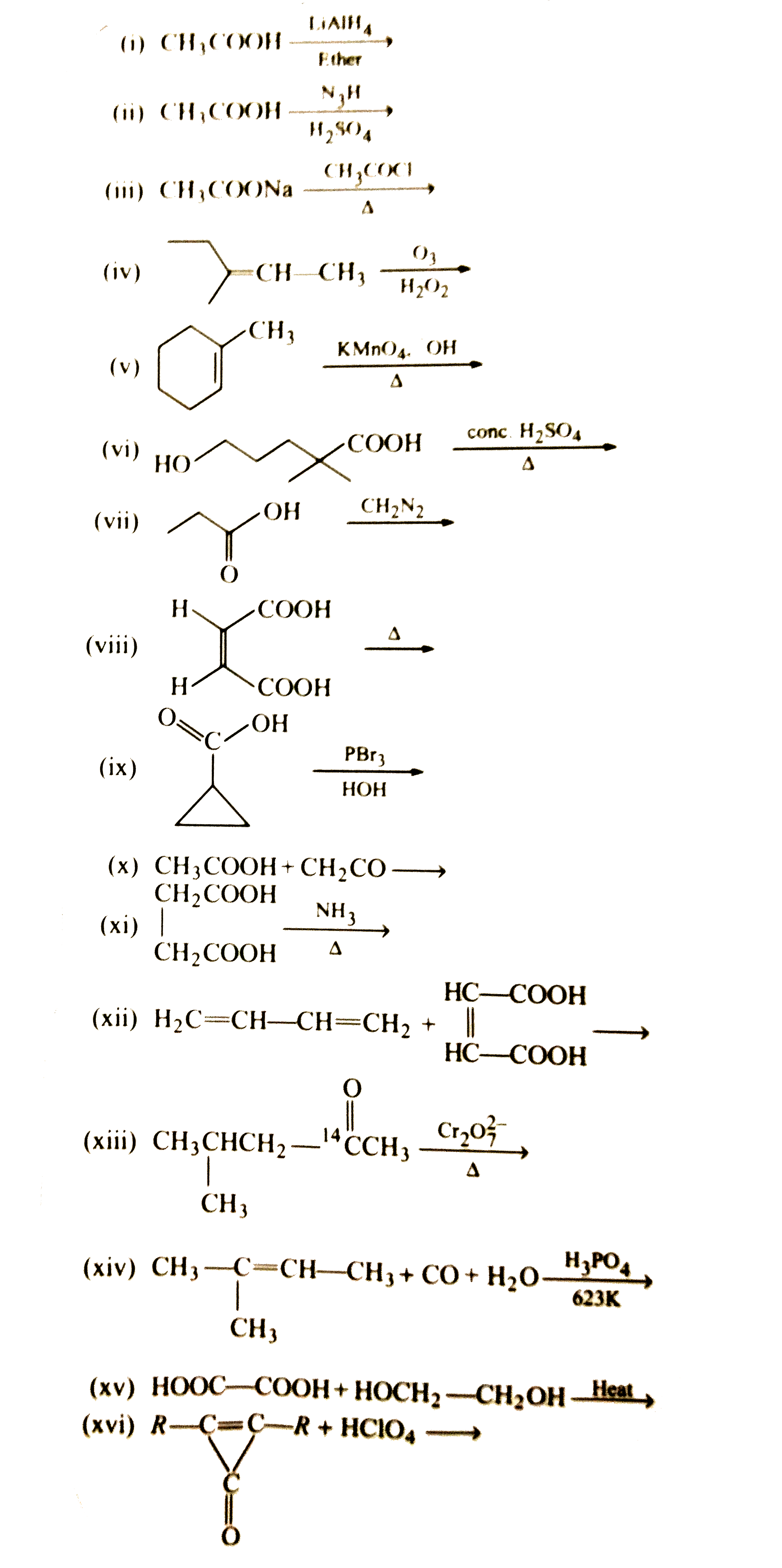

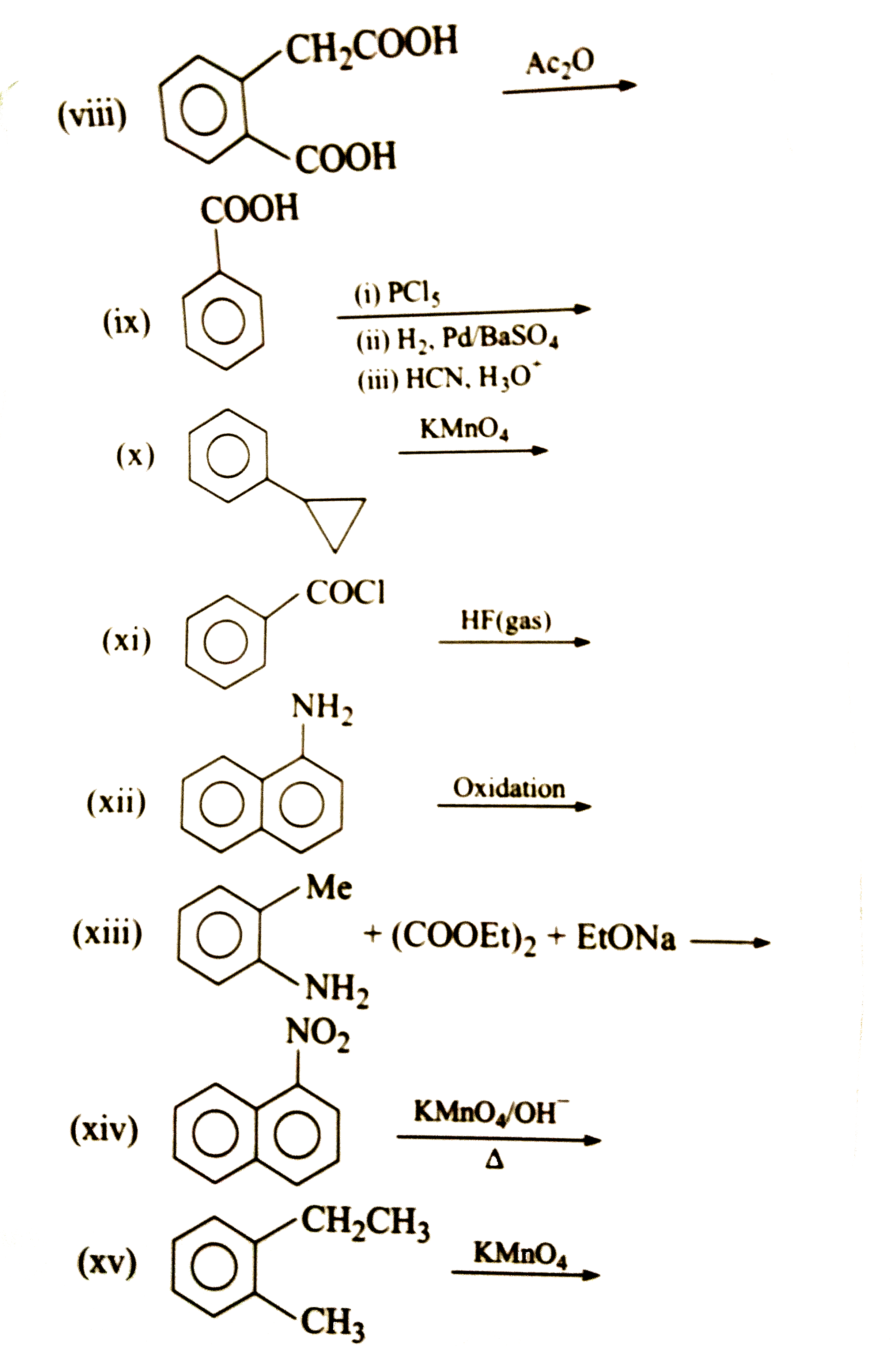
View SolutionComplete the following equation by writing the missing (A),(B),(C ),(D) etc. :

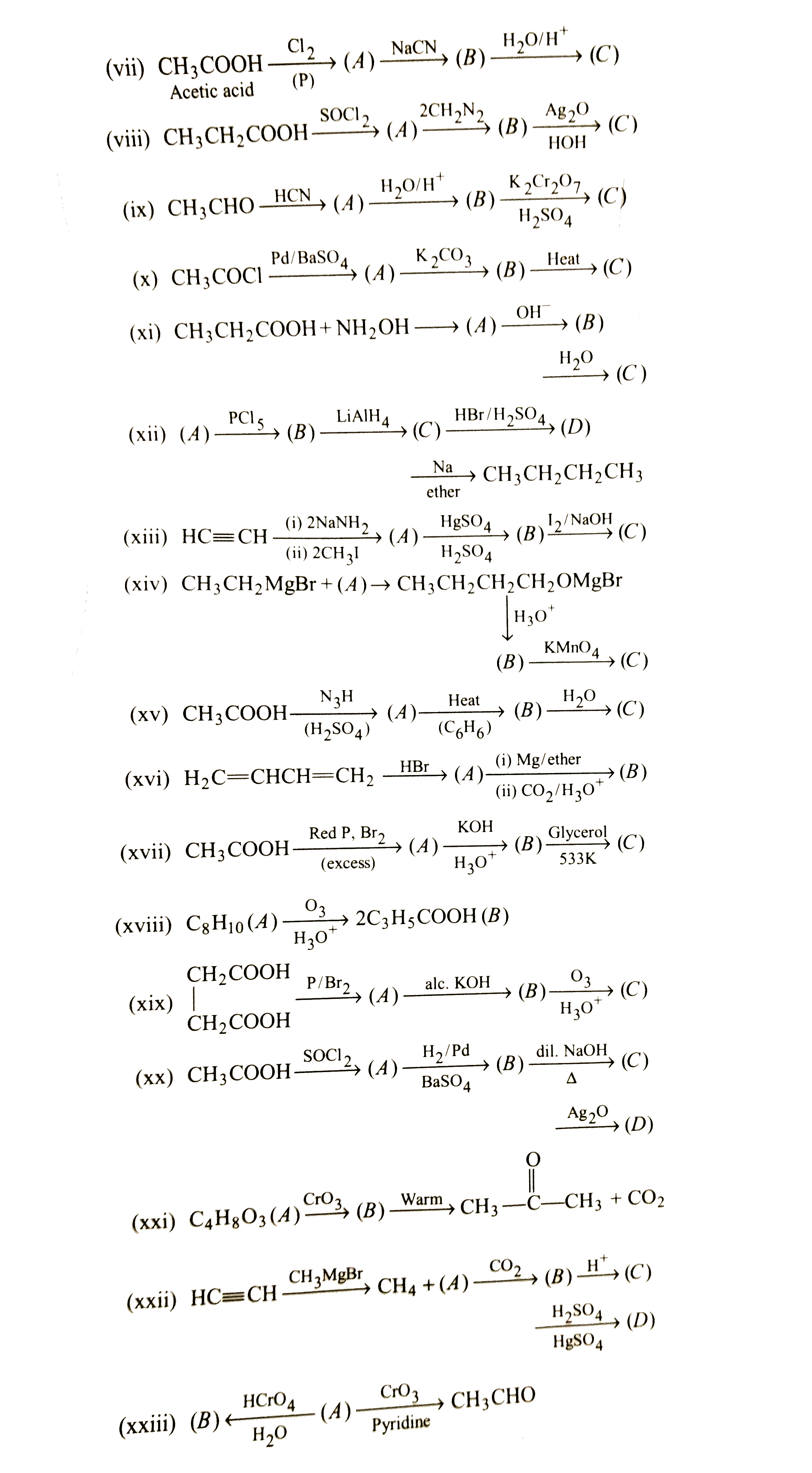
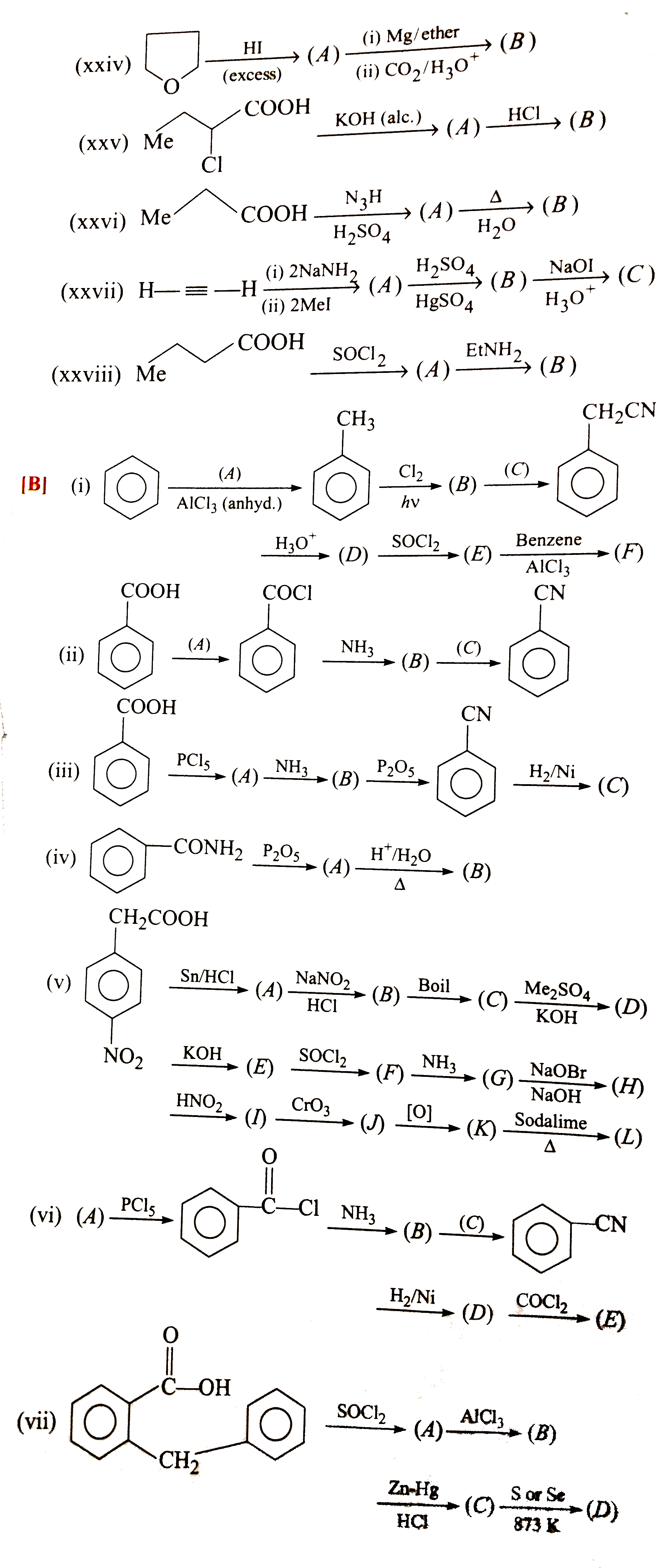
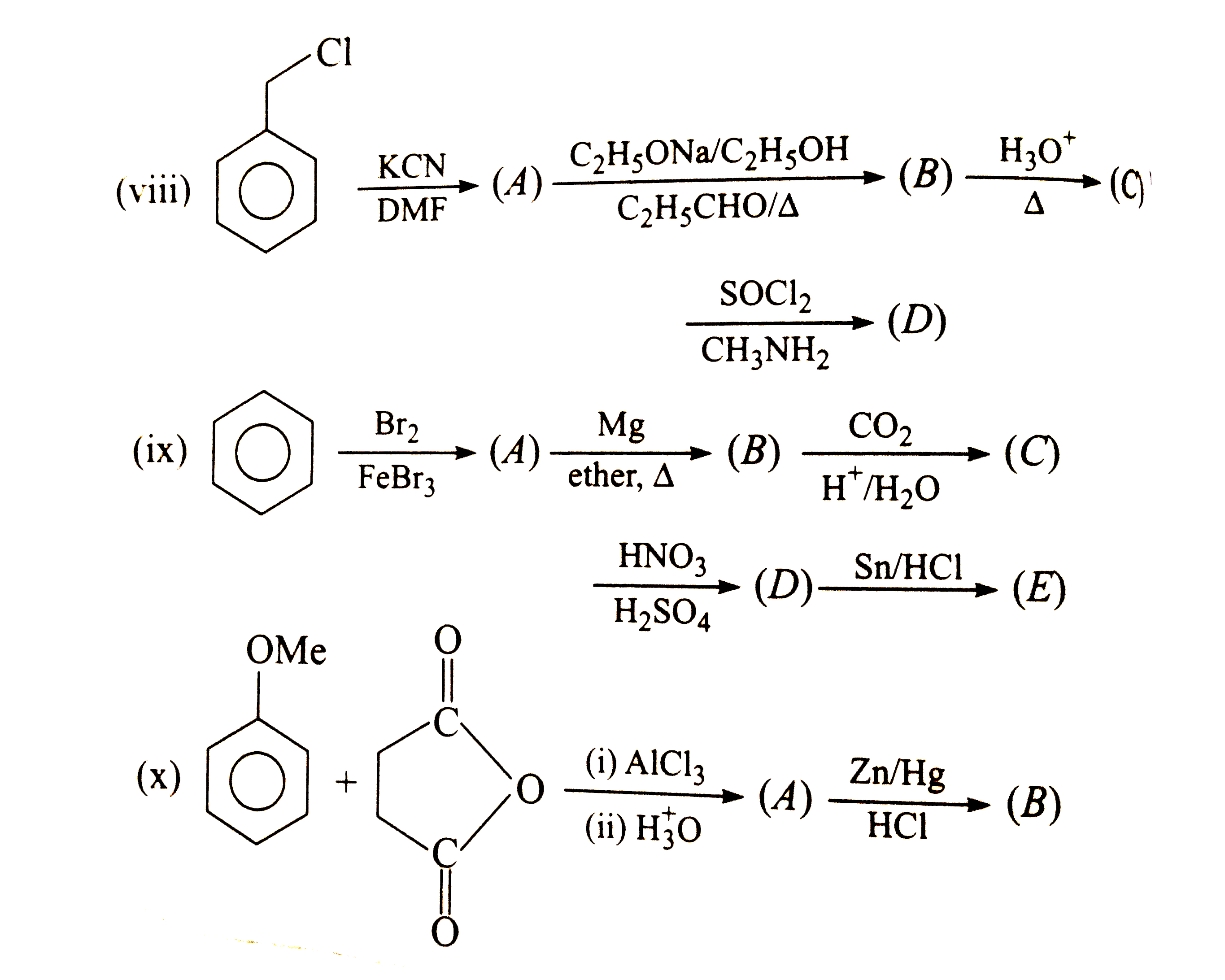
View SolutionWhat happens when?
(i) Formic acid is heated with conc. `H_(2)SO_(4)`
(i) Dry chlorine is passed through acetic acid in presenece of sunlight
(iii) Oxalic acid is heated with glycerol.
(iv) Formic acid is reacted with ammoniacal silver nitrate solution
Glacial acetic acid is heated at 973 K
(vi) Formic acid is heated with Fehling's solution
(vii) Ammonium acetate is dry distilled.
(viii) Acidified potassium permanganate is added to oxalic acid
(ix) Oxalic acid is heated.
(x) Maleic acid is heated.
(xi) A carboxylic acid is treated with lithium aluminium hydride.
(xii) Acetic acid reacts with thionyl chloride.
(xiii) Tartaric acid is treated with hydrogen iodide.
(xiv) Lactic acid is heated.
(xv) Citric acid is refluxed with hydriodic acid.
View SolutionDefine the term fatty acids. Give the common and IUPAC names for the following fatty acids:
(i) `CH_(3) (CH_(2))_(14) COOH`
(ii) `CH_(3) (CH_(2))_(16) COOH`
(ii) `CH_(3) (CH_(2))_(7) CH=CH(CH_(2))_(7) COOH`
View SolutionSuggest five possible compounds from `(CH_(3))_(2) CHCOOH` can be prepared in good yield by oxidation.
View SolutionHow would you distinguish between:
(a) solutions of acetic acid, fornmic acid and ethanol
(b) calcium formate and calcium acetate?
(c) maleic acid and fumaric acid?
(d) acetic acid and acetone?
(e) acetic acid and acrylic acid?
(f) tartaric acid and citric acid?
(g) Benzoic acid and cinnamic acid?
View SolutionHow will you synthesise?
(i) Acetic acid from methyl iodide
(ii) Iodoform irom acetic acid,
(iii) Acetic acid from propionic acid.
(iv) Glycine from acetic acid (v) Butylamine from propionic acid.
(vi) Ethylamine from propionic acid.
(vii) `alpha`-Hydroxy propionic acid from acetaldehyde
(viii) Acetamide from acetone. (ix) Acetaldehyde from acetic acid
(x) Methyl cyanide from acetic acid.
(xi) Crotonic acid from acetaldehyde.
(xi) Pyruvic acid from ethyl bromide (xiit) Succinic acid from ethyl bromide
(xiv) Oxalic acid from methyl alcohol.
(xv) B-Hydroxy propionic acid from ethylene oxide.
(xvi) Tartaric acid from ethylene.
(xvii) Malonic acid from acetic acid.
(xviii) Lactic acid from acetic acid.
(xix) 2-Phenylethanoic acid from benzene.
(xx) p-Carboxyphenylacetic acid from p chlorotoluene
(xxi) m-Fluorobenzoic acid from benzoic acid
(xxii) o-Bromobenzoic acid from toluene.
(xxiii) Aniline from benzoic acid.
(xxiv) Salicylic acid from benzene.
(xxv) Cinnamic acid from benzene.
(xxvi) p-Met ylbenzoic acid from toluene.
(xxxvii) p-Hydroxy benzoic acid from toluene.
(xxviii) Benzoic acid from aniline.
(xxix) Aniline from benzoic acid.
(xxx) Phthalimide from phthalic acid.
View SolutionHow will you bring about the following conversion ?
'Ethanoic acid to a mixture of methanoic acid and diphenyl ketone'.
View SolutionWhat is the action of heat on the following?
(i) Oxalic acid, (i) Ammonium oxalate,
(iii) Calcium formate, (iv) Calcium acetate,
(v) Sodium formate, (vi) Malonic acid
(vii) Adipic acid, (vi) Succinic acid
View SolutionArrange the following in order of increasing acidity:
(i) Propanoic acid, chloroethanoic acid, 3-bromo-propanoic acid and trichloroacetic acid.
(ii) 2-Fluorobutanoic acid, 2-iodobutanoic acid, 2-bromobutanoic acid and butanoic acid.
(iii) (iii) Acetic acid, 2-methyl propanoic acid, 2,2-dimethyl propanoic acid.
(iv) Oxalic acid, malonic acid, succinic acid, glutaric acid.
(v) `C_(6)H_(5)COOH, p-OHC_(6)H_(4)COOH,`
`p-CH_(3)C_(6)H_(4)COOH, p-CIC_(6)H_(4)COOH,`
`p-BrC_(6)H_(4)COOH, p-NO_(2)C_(6)H_(4)COOH.`
View SolutionAnswer the following:
(i) Why 100 % pure acetic acid is named glacial acetic acid?
(ii) What is vinegar and how is it made?
Why the C-O in RCOOH is less reactive towards nucleophiles than in aldehydes and ketones?
View SolutionAccount for the following:
(a) Carboxylic acids with five or fewer carbon atoms are water soluble but, higher ones are insoluble.
(b) Highly branched carboxylic acids are less acidic than unbranched acids.
(c) Acetic acid can be halogenated in prescnce of phos-phorus and chlorine but formic acid cannot be halogenated in the same way.
(d) carbon-oxygen bonds length in formic acid are 1.23 Å and 1.36 Å but in sodium formate both carbon oxygen bonds have same value, i.e., 1.27 Å.
Formic acid is stronger than acetic acid.
(f) Fluoroacetic acid is stronger than chloroacetic acid
(g) Formic acid shows reducing properties.
(h) `beta`-Keto acids undergo decarboxylation easily.
(i) o-Hydroxybenzoic acid is stronger than p-hydroxy benzoic acid.
(ii) Oxidation of toluene by acidic `KMnO_(4)` gives poor yield of benzoic acid while oxidation of p-nitro toluene gives good yield of p-nitrobenzoic acid.
View SolutionGive the decreasing order of ease of decarboxylation of the following acids on heating with sodalime,
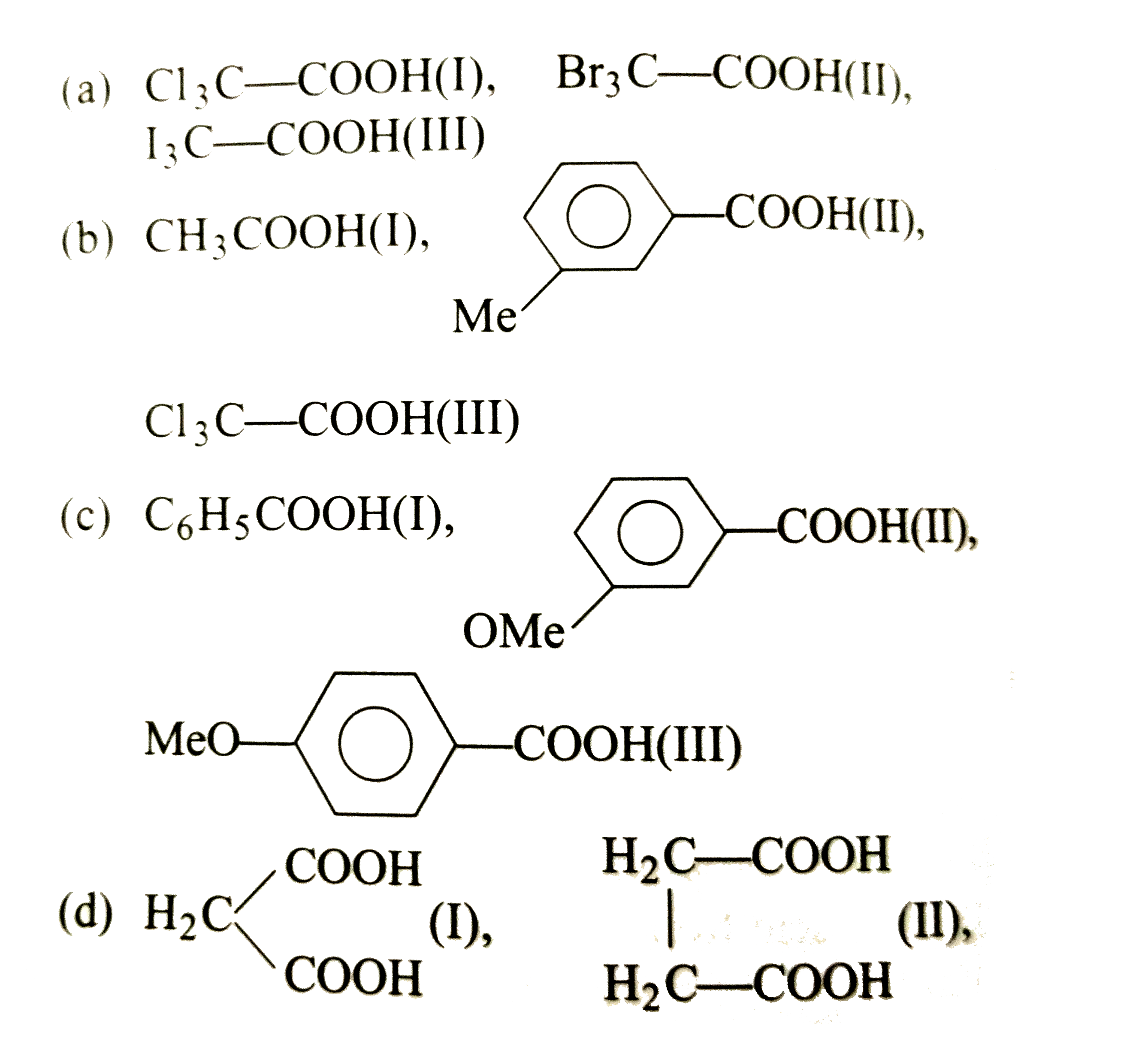
View SolutionWhich of the carboxylic acid among following pairs will undergo decarboxylation readily?

View SolutionHow benzoic acid is prepared from each of the following substances?
(i) Toluene (ii) Benzene (iii) Phenylcyanide (iv) Benzaldehyde (v) Benzylalcohol (vi) Benzoylchloride (vii) Benzotrichloride
View SolutionMatch the following
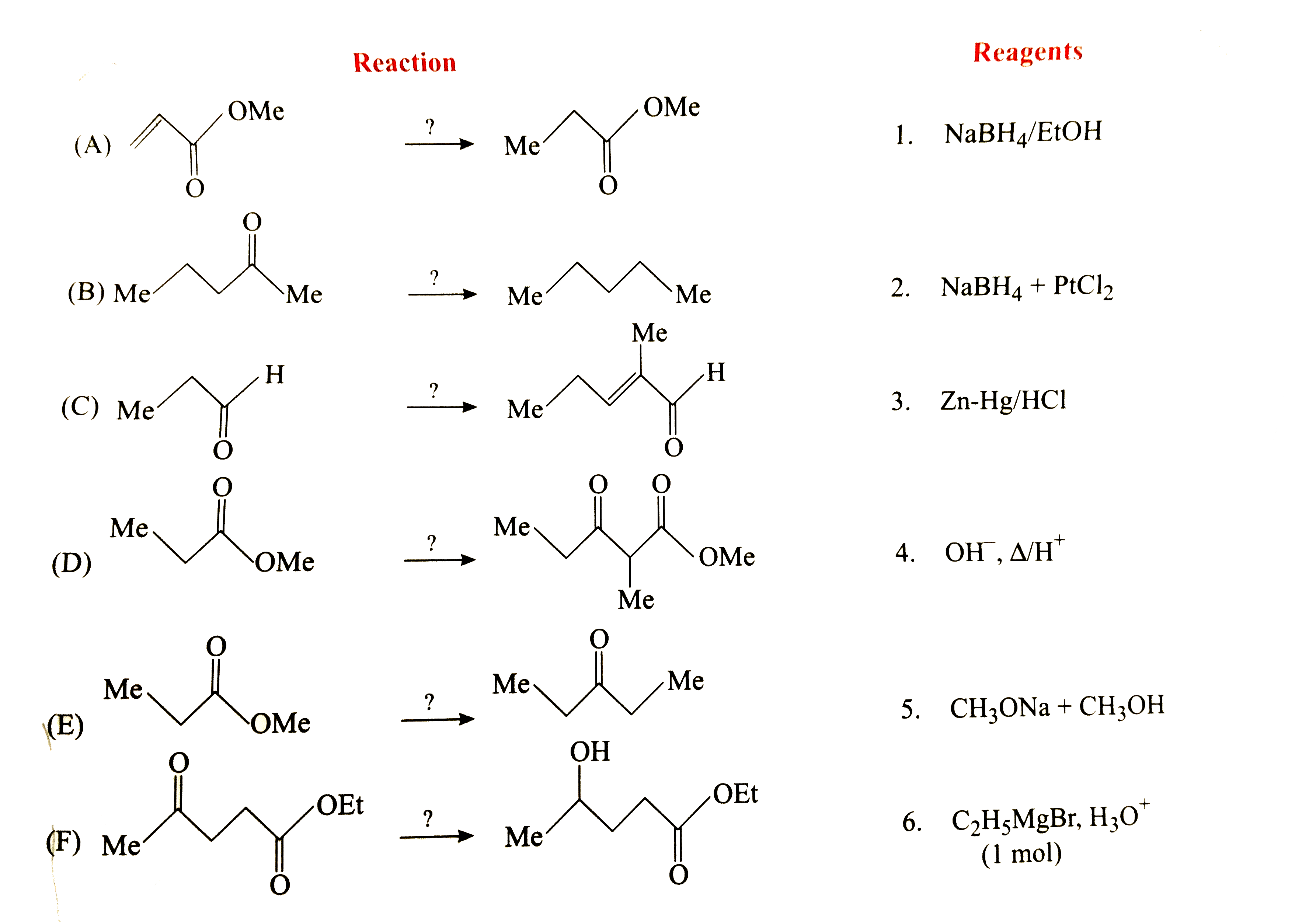
View SolutionMatch the following

View SolutionWhat happens when?
(i) Acetamide is heated with bromine and caustic potash.
(ii) Acetyl chloride reacts with water.
(iii) Acetyl chloride is distilled with sodium acetate.
(iv) Acetamide reacts with nitrous acid.
(v) Acetamide reacts with phosphorus pentoxide.
(vi) Oils and fats are heated with NaOH.
(vii) Acetyl chloride reacts with ethyl alcohol.
(viii) Acetic acid is treated with `P_(2)O_(5)` .
(ix) Urea is heated.
(x) Conc. `HNO_(3)` is added to concentrated urea solution.
(xi) Urea is heated with nitrous acid.
(xii) Urea is heated with sodium hydroxide solution.
(xiii) Urea is heated with acetyl chloride.
(xiv) The solution containing potassium cyanate and ammonium sulphate is evaporated to dryness.
(xv) Ammonia and carbon dioxide mixture is heated under pressure
View SolutionComplete the following reactions
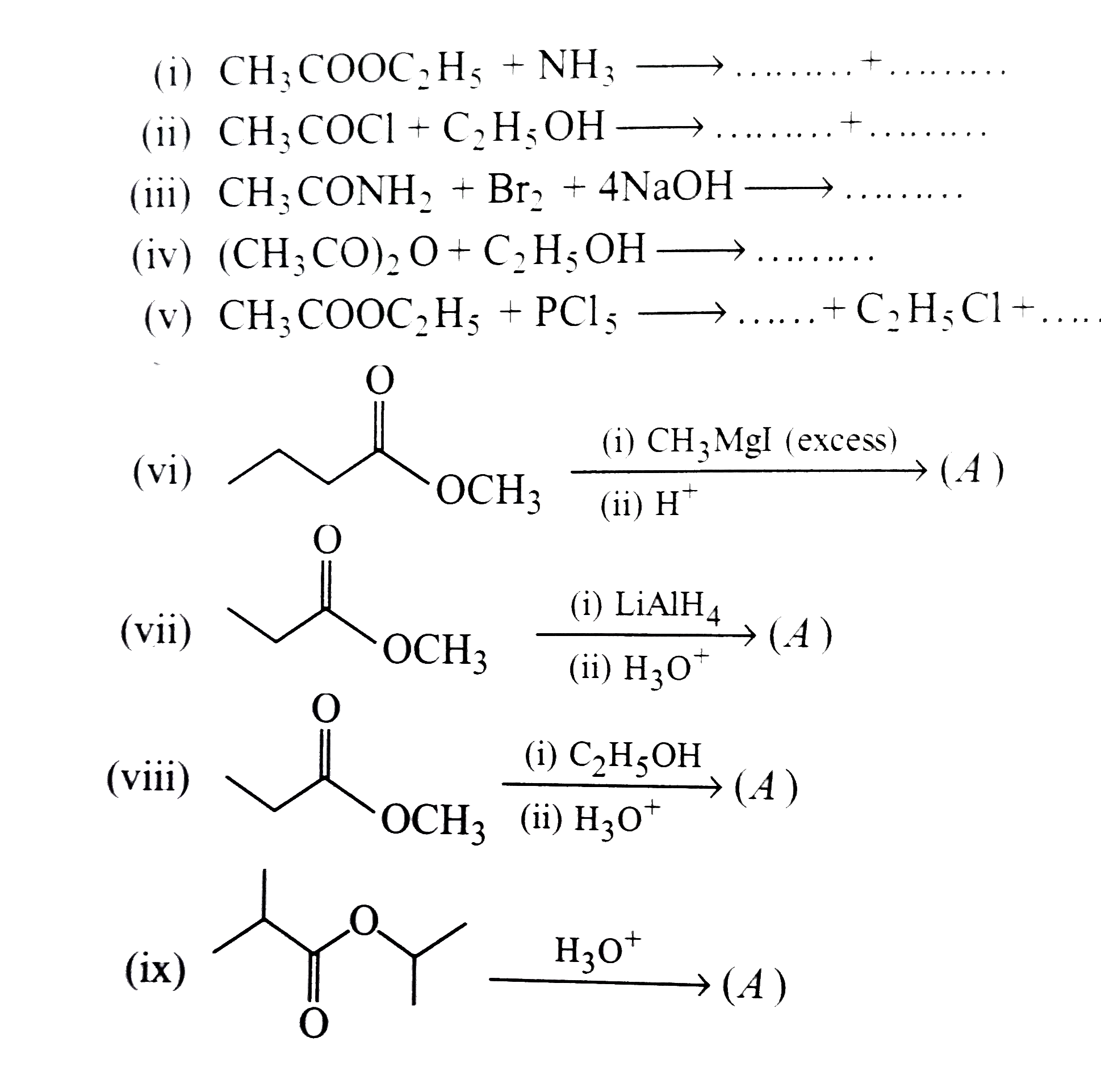
View SolutionIdentify (A), (B), (C), (D) and(E), …in the following equations



View SolutionWhat reagents are required for making the following changes in functional groups?
(a) ` -CHOto -CH_(2)`OH (b) `-CN to-COOH`
(c) `-COOHto H` (d) `-CONH_(2) to -NH_(2)`
View SolutionHow will you synthesize?
(i) Acetyl chloride from methyl chloride.
(ii) Acetamide from ethyl alcohol.
(iii) Methylamine from acetyl chloride.
(iv) Acetamide from acetone.
(v) Acetic anhydride from acetic acid.
(vi) Ethyl acetate from ethyl bromide.
(vii) Ethyl acetate from acetic acid.
(viii) tert-Butyl ethanoate from acetic acid.
(ix) Pantan-3-one from ethyl propanoate.
(x) Acetone from ethyl acetate
View SolutionList three reagents for converting a carboxylic acid to its acyl chloride. Select the most convenient of the three reagents. Give a reason for the choice. ?
View SolutionGive the industrial preparation of acetic anhydride. How many other anhydrides be prepared from acetic anhydride?
View SolutionDistinguish between the following pairs:
(i) Urea and ammonium acetate
(ii) Ethanoic acid and ethanoyl chloride
(iii) Ethyl ethanoate and ethanamide
(iv) Ethanoic anhydride and methyl ethanoate
( v) Salt and ester
(vi) Acetamide and urea
(vii) Kerosene oil and vegetable oil
View SolutionAnswer the following with reasoning:
(i) Why all the acid derivatives (RCOG) [G may be -X (acid halides), `-NH_(2)` (amides), OR' (esters) or -OCOR (anhydrides)] are studied as a unit?
(ii) Why the C-G bond in acid derivatives is expected to be shorter and stronger than in alkyl derivatives (R-G)?
(iii) Why esters have lower boiling points than (a) ketones and (b) acids of comparable molecular masses?
(iv) Amongst the following amides, `CH_(3)CONH_(2), CH_(3)CONHCH_(3) and CH_(3)CON(CH_(3))_(2)`, why acetamide has the highest boiling point and `CH_(3)CON(CH_(3))_(2)` the minimum boiling point?
(v) How the order of reactivity of the acid derivatives is related to the base strength of the leaving groups?
(vi) Why cannot HCl convert RCOOHto RCOCl?
(vii) Why does an acyl chloride undergo nucleophilic attack more rapidly than does an alkyl chloride?
(viii) What is the essential difference between nucleophilic attack on the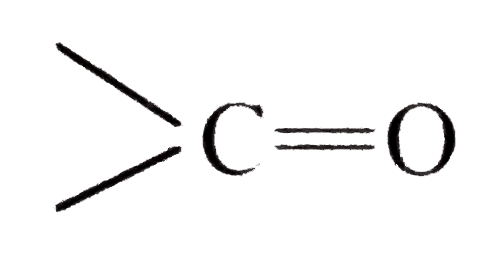 of an aldehyde or ketone and on an acyl derivative?
of an aldehyde or ketone and on an acyl derivative?
(ix) Why a ketone is not isolated from the reaction of an ester with one equivalent of RMgX?
(x) Amongst the following esters, `CH_(3)COOC_(4)H_(9),CH_(3)COOC_(3)H_(7),CH_(3)COOCH(CH_(3))_(2) and CH_(3)COOCH_(3)` : why `CH_(3) COOCH_(3)` is most readily hydrolysed with NaOH?
(xi) Why formic anhydride cannot be prepared by heating formic acid?
(xii) Primary and secondary amides exist as dimers in the solid and pure liquid state.
(xiii) Why urea is basic?
(xiv) Why guanidine is a strong monoacid base?
(xv) Why melting point of primary amide is higher than secondary and tertiary amides?
View SolutionHow does urea react with?
(a) Nitrous acid,
(b) Dilute NaOH,
(c) Sodium hypobromite,
(d) Malonic ester,
(e) Hydrazine,
(t) Acetyl chloride,
(g) Succinic acid,
(h) Acetoacetic ester.
View Solution(a) What are ureides? (b) What are barbiturates?
( c) How urea is estimated?
View Solution(i) Give the mechanism for the reaction of acetyl chloride with ethyl alcohol.
(ii) Give the mechanism for the Hofmann bromamide reaction.
(iii) Give the mechanism of estrification
(iv) Give the mechanism of basic hydrolysis of an ester.
or
Give the mechanism of saponification.
(v) Give the mechanism of acid hydrolysis of an ester.
View SolutionMatch the following:

View SolutionDifferent possible thermal decomposition pathways for peroxy esters are shown below. Match each pathway from list I with an appropriate structure from list II and select the correct answer using the code given below the list.
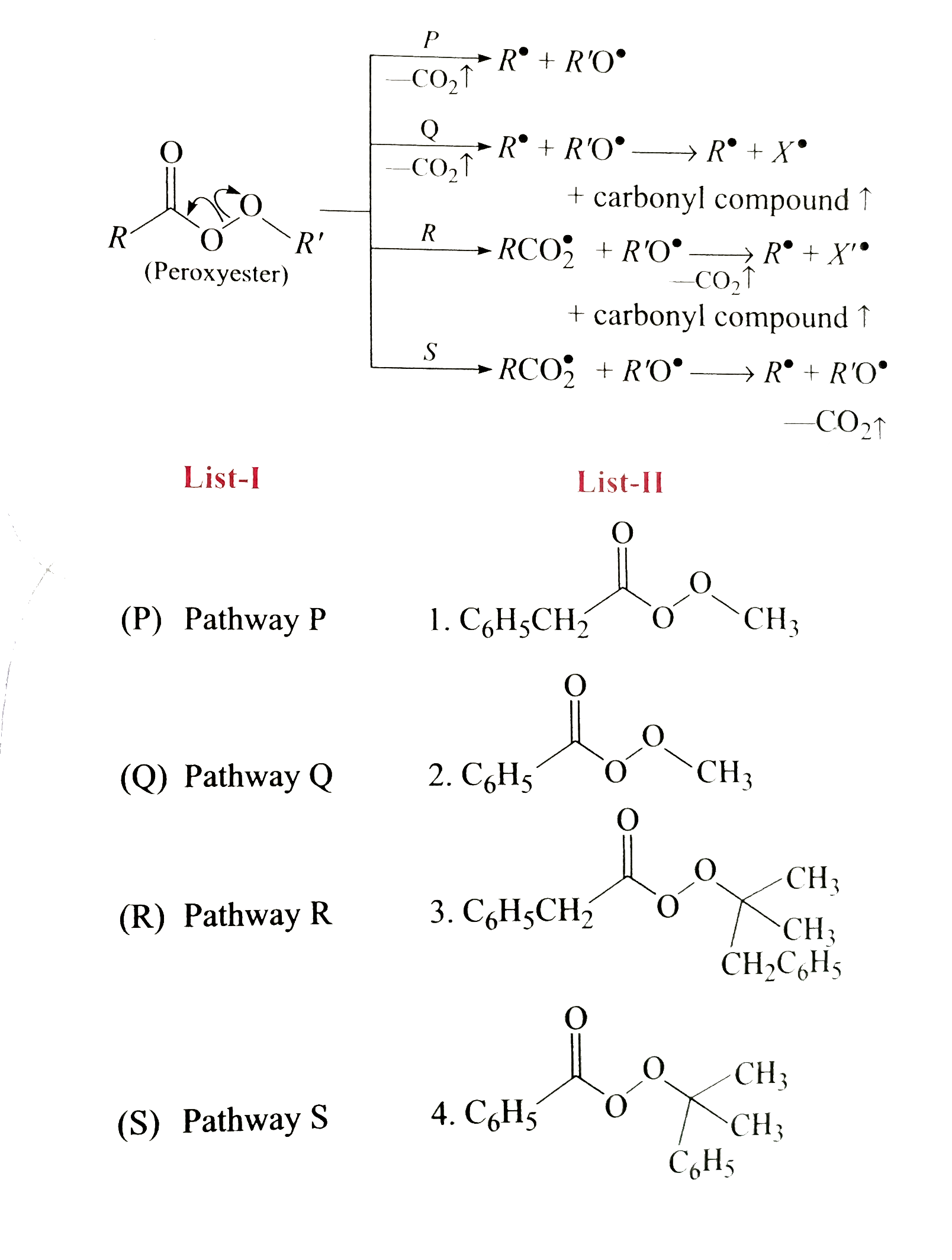
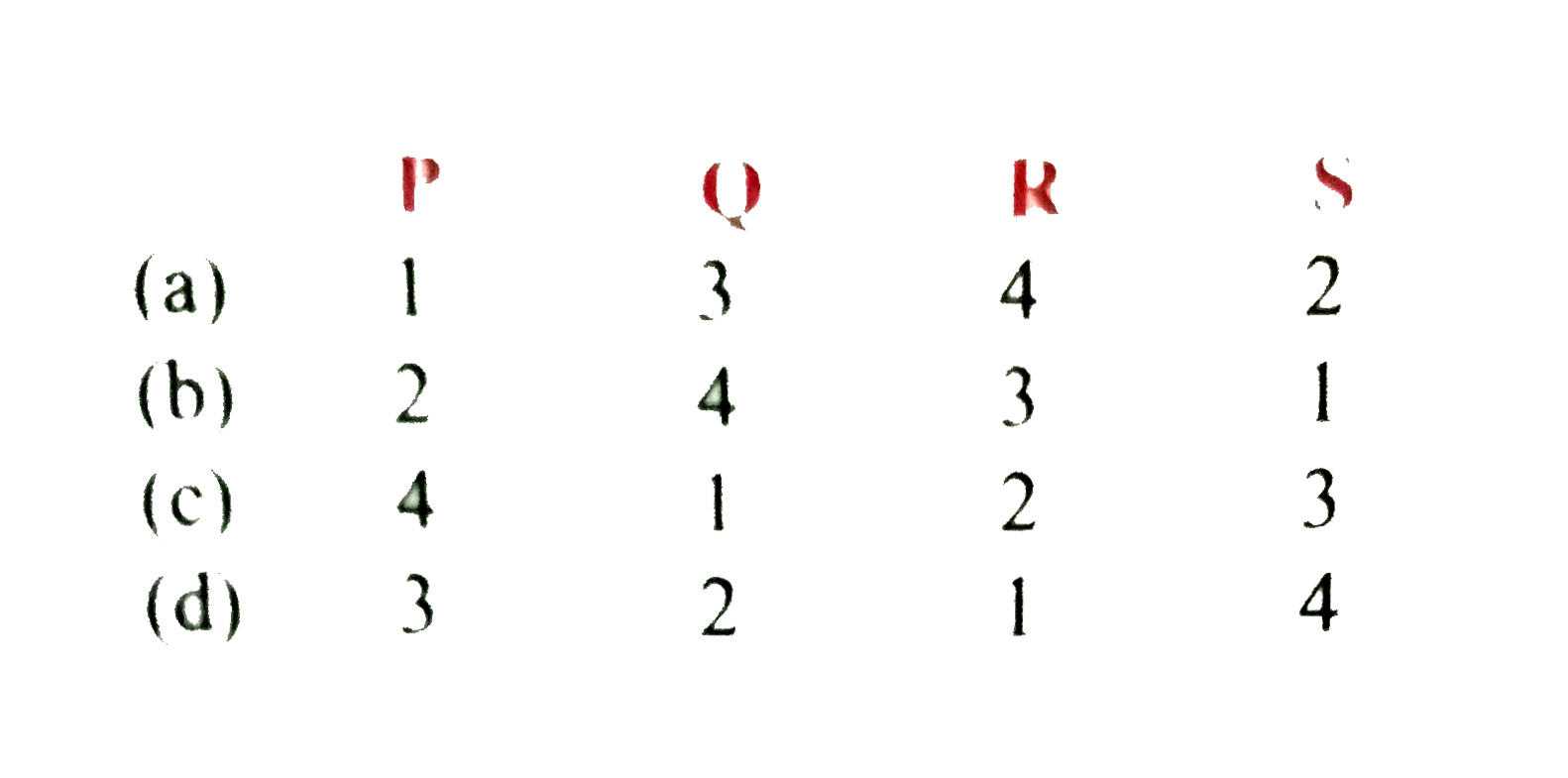
View Solution
problem for practise questions and complete solutions for chapter CARBOXYLIC ACIDS AND THEIR DERIVATIVES of G.R. BATHLA & SONS CHEMISTRY (HINGLISH) of Class 12